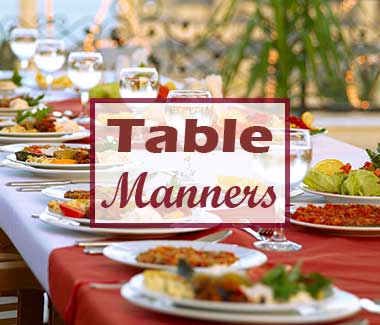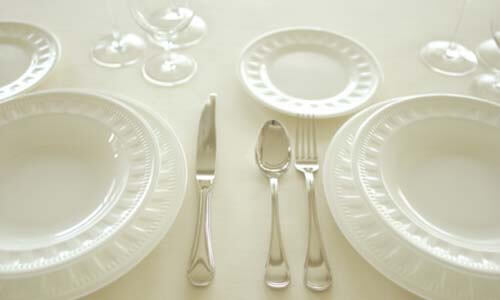Utensil Etiquette
Soupspoon Etiquette
The soup spoon is made with oval or round bowls to accommodate the consistency of soup. An oval soup spoon has a an oval bowl, which makes it easy pieces of food in soup form the tip. The bowl of a round soup spoon has a curved edge, which allows the clear or pureed soup to be sipped from the side.
To avoid spills, the soup spoon is filled no more than two-thirds full.
Fish Knife and Fork Etiquette
The fish knife is used to separate the soft flesh of the fish from the body rather than to cut a bite. Since leverage is not required to separate fish, the handle of the fish knife is held in the right hand toward the end of the shank, between the thumb and the first two fingers, a position different than the way a dinner knife is held. The tip of the blade is used to fillet fish, lift the skeleton from the body, and ferret out small bones. Table manners provide that the fish fork is held in the left hand and used in the traditional way.
Dessert Fork and Spoon Etiquette
To steady the portion, the dessert fork is held in the left hand, tines downward. Table manners require that the dessert spoon be held in the right hand to cut and convey a bite to the mouth.
Teaspoon Etiquette
Because proper table manners require that a soiled utensil not be laid on the table after it is used, while drinking an iced beverage, the user holds the teaspoon in the glass against the rim with the index finger (where it remains until the glass is cleared from the table).
Chopsticks
Due to cultural differences, there really is no one rule for handling. The correct method for handling chopsticks in Japan, might not be appropriate chopstick etiquette in Korea or Japan. With that said, we present first general chopsticks etiquette followed by regional differences.
Universal Chopstick Etiquette
- Do not use chopsticks to make noise, draw attention, or gesture.
- Do not use chopsticks to move plates or bowls.
- Generally, do not use chopsticks to impale food.
- Do not leave chopsticks standing vertically in a bowl of rice or other food.
Steps for Using Chopsticks
Place one chopstick in the webbing of your thumb and rest the other end on your curled third and fourth fingers.
Place the second chopstick between your first and second fingers, and hold it down with the tip of your thumb.
Make sure the chopsticks are even from top to bottom.
To grasp food, move only the top chopstick, and leave the bottom one firm and steady. Do not allow the broad ends of the chopsticks do not make an "X" as this will make it difficult to pick up food.
Chinese Chopsticks Etiquette
Hong Kong and Cantonese Chopsticks Etiquette
Wait for the eldest family member to hold his or her chopsticks first.
Do not use chopsticks backwards, except to stir or transfer the dish to another plate (but only if there are no serving chopsticks).
When finished eating, place your chopsticks on the top of your bowl. If you are not finished eating, place your chopsticks on a chopstick stand.
Taiwanese Chopsticks Etiquette
Do not transfer food from chopsticks-to-chopsticks.
Do not rest chopsticks on the table. Use a chopstick rest or place them sideways across the rice bowl. When finished eating, place your chopsticks flat on the bowl.
Do not bite your chopsticks or keep them in your mouth too longer.
Japanese Chopsticks Etiquette
Do not transfer food from chopsticks-to-chopsticks.
Place the pointed ends of the chopsticks on a chopstick rest when the chopsticks are not being used. If a rest is not available, make a chopstick rest by folding the paper case that the chopsticks came in.
You may reverse your chopsticks to use the clean end when moving food from a communal plate, but it is considered better to ask for extra chopsticks to transfer the food in this situation.
Do not cross chopsticks on a table, or vertically stick them in the rice.
Do not rub wooden chopsticks together after breaking them apart.
Place chopsticks in a right-left direction - with the tips on the left. Do not place chopsticks diagonally, vertically or crossing each other.
At the end of the meal, place disposable chopsticks into the wrapper they came in.
Korean Chopsticks Etiquette
Chopsticks commonly are paired with a spoon.
Do not pick up your bowl and bring it close to your mouth. Leave your dishes on the table.
Never lay your chopsticks down to the left of your spoon.
Vietnamese Chopsticks Etiquette
Raise your bowl to your mouth and push rice into your mouth with your chopsticks.
Always use both chopsticks together, even if only stirring something.
Food should not be picked up from the table and placed directly into your mouth. Place all food in your own bowl before eating.
Do not place chopsticks in a "V" when you have finished eating.



